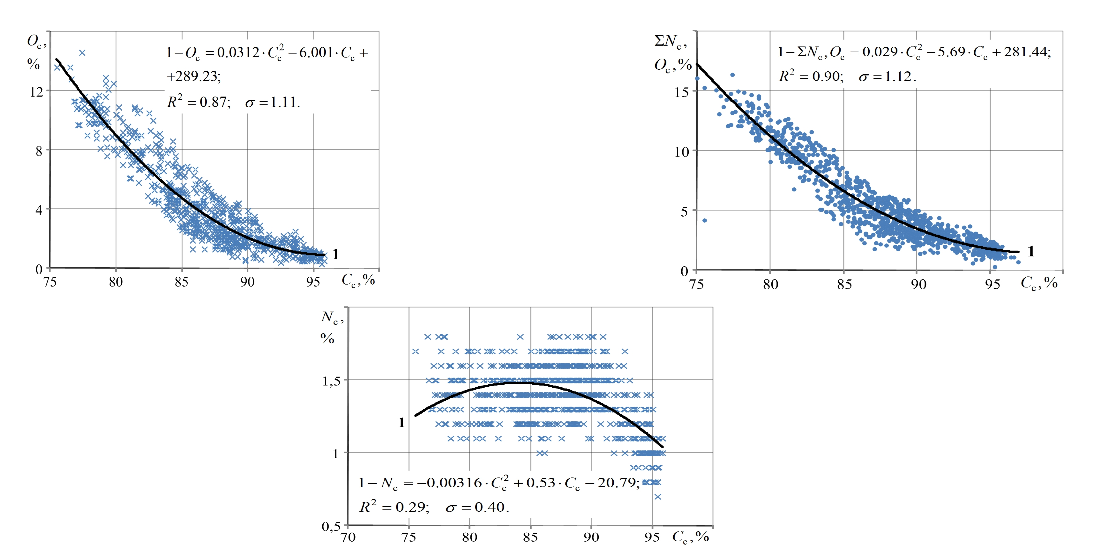Analysis of metamorphism and tendency of coal seams and their hazardous properties
DOI:
https://doi.org/10.15587/2706-5448.2022.266455Keywords:
physico-chemical properties of coal, hazardous properties of mine seams, coal quality, ash yield, moisture contentAbstract
The object of this study is coals of different stages of metamorphism. Currently, a situation has arisen when indicators developed to establish the consumer qualities of coal are used to predict the manifestation of hazardous properties of mine seams during mining operations. The need to consider the fuel for its working condition is due to different end goals between the establishment of consumer qualities of coal and the manifestation of the hazardous properties of mine seams. The condition and quality of coal after its preparation for use is significantly different from the condition in the mining area. Appropriate sample preparation changes the physical and chemical properties of coals, which determine the manifestation of the hazardous properties of mine layers during mining. To eliminate such a discrepancy, the quality indicators of coals were recalculated for their working condition, taking into account the yield of ash and moisture content for the mined mine seams, followed by an analysis of changes in the correlations be-tween the indicators. The indicators of the manifestation of the hazardous proper-ties of mine layers are borrowed from the characteristics of the quality of the fuel, reduced to a dry, ash-free state. Using these indicators, additional errors are introduced in advance into the accuracy of the prediction of the manifestation of hazardous properties during mining operations. The values of the indicators of the organic (combustible) part of the fuel serve as general reliable characteristics of its quality for the entire set of mine seams, but they cannot be used to predict the hazardous properties of a particular mine seam due to a decrease in the accuracy of their determination due to the unpredictable content of mineral impurities and moisture. The initial experimental data, which have been accumulated over several decades based on the experience of using coal for industrial purposes, are analyzed. On the basis of the conducted researches the peculiarities of the choice of indicators of metamorphic transformations of coal, which are used in parallel respectively to establish the quality of fuel and forecast the dangerous properties of coal seams, have been established. The discrepancies between the indicators of the degree of metamorphism used in the current regulatory framework for the safe conduct of mining operations, the state of fuel during mining operations in underground conditions.
References
- Williams, F. A. (1977). Mechanisms of fire spread. Symposium (International) on Combustion, 16 (1), 1281–1294. doi: https://doi.org/10.1016/s0082-0784(77)80415-3
- Stracher, G. B., Taylor, T. P. (2004). Coal fires burning out of control around the world: thermodynamic recipe for environmental catastrophe. International Journal of Coal Geology, 59 (1-2), 7–17. doi: https://doi.org/10.1016/j.coal.2003.03.002
- Du, J., Chen, J., Pu, Y., Jiang, D., Chen, L., Zhang, Y. (2021). Risk assessment of dynamic disasters in deep coal mines based on multi-source, multi-parameter indexes, and engineering application. Process Safety and Environmental Protection, 155, 575–586. doi: https://doi.org/10.1016/j.psep.2021.09.034
- Song, Z. (2022). Modelling oxygen-limited and self-sustained smoldering propagation: Underground coal fires driven by thermal buoyancy. Combustion and Flame, 245, 112382. doi: https://doi.org/10.1016/j.combustflame.2022.112382
- Niu, H., Sun, Q., Bu, Y., Chen, H., Yang, Y., Li, S. et al. (2022). Study of the microstructure and oxidation characteristics of residual coal in deep mines. Journal of Cleaner Production, 373, 133923. doi: https://doi.org/10.1016/j.jclepro.2022.133923
- Kolker, A., Engle, M., Stracher, G., Hower, J., Prakash, A., Radke, L. et al. (2009). Emissions from coal fires and their impact on the environment. Fact Sheet, 3084. doi: https://doi.org/10.3133/fs20093084
- Antoshchenko, M. I., Tarasov, V. Y., Rudniev, Ye. S., Zakharova, O. I. (2021). On the Issue of Establishing the Stages of Coal Metamorphism for Predicting the Hazardous Properties of Coal Seams. Nature Environment and Pollution Technology, 20 (4), 1495–1503. doi: https://doi.org/10.46488/nept.2021.v20i04.011
- GOST 25543-2013. Mezhgosudarstvennyi standart. Ugli burye, kamennye i antratcity. Klassifikatciia po geneticheskim i tekhnologicheskim parametram. (2014). Moscow: Standartinform, 19.
- ASTM International (2012). Standard Classification of Coals by Rank: D388-15. ASTM International West Conshohocken, 7. doi: https://doi.org/10.1520/d0388-15
- Liu, F. (2022). A comparison between multivariate linear model and maximum likelihood estimation for the prediction of elemental composition of coal using proximate analysis. Results in Engineering, 13, 100338. doi: https://doi.org/10.1016/j.rineng.2022.100338
- Thomas, L. (1992). Handbook on practical coal geology. N. p., United States, 338.
- Grzebyk, W., Stolecki, L. (2015). Volumetric changes of rock massif preceding mining seismic events. International Journal of Rock Mechanics and Mining Sciences, 80, 147–154. doi: https://doi.org/10.1016/j.ijrmms.2015.09.020
- Spravochnik po kachestvu i obogatimosti kamennykh uglei i antratcitov Ukrainskoi SSR (Donbass v granitcakh USSR, Lvovsko-Volynskii bassein) (1965). Kharakteristika kachestva kamennykh uglei i antratcitov Ukrainskoi SSR. Moscow: Nedra, 204.
- Spravochnik po kachestvu kamennykh uglei i antratcitov Donetckogo i Lvovsko-Volynskogo basseinov (1972). Donetckii nauchno-issledovatelskii ugolnyi institut. Moscow: Nedra, 168.

Downloads
Published
How to Cite
Issue
Section
License
Copyright (c) 2022 Yevhen Rudniev, Mykola Antoshchenko, Mykhailo Filatiev, Elvira Filatieva, Vadym Tarasov

This work is licensed under a Creative Commons Attribution 4.0 International License.
The consolidation and conditions for the transfer of copyright (identification of authorship) is carried out in the License Agreement. In particular, the authors reserve the right to the authorship of their manuscript and transfer the first publication of this work to the journal under the terms of the Creative Commons CC BY license. At the same time, they have the right to conclude on their own additional agreements concerning the non-exclusive distribution of the work in the form in which it was published by this journal, but provided that the link to the first publication of the article in this journal is preserved.







